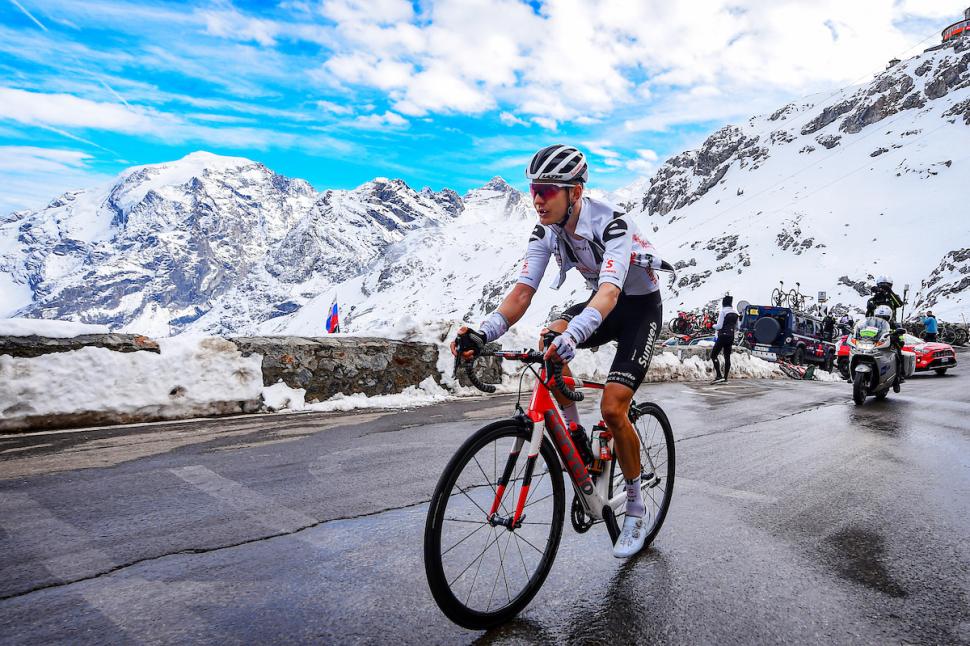One of the defining images of this strangest of years in professional cycling was Jai Hindley and Tao Geoghegan Hart duking it out on the famed, snow-dusted slopes of the Stelvio as the Giro d’Italia enjoyed its decisive day. Hindley won, despite nearly falling off trying to get his rain jacket on. His Sunweb team-mate Wilco Kelderman cracked, even though he took the race lead later that day. This battle to the top was the launch pad for Geoghegan Hart – Geraint Thomas’ Ineos Grenadiers’ team-mate – to become the surprise winner of the maglia rosa.

Geoghegan Hart said the Stelvio was “crazy”. Thomas, in his new book Mountains According To G, says it “looks like a strawberry bootlace pulled out of the packet, all bent back on itself and going on, and on and on.”
The strawberry bootlace simile is key to the everyday charm of Thomas’ book written “with Tom Fordyce”, taking us on a trip up if not the toughest climbs in world cycling, then the ones that mean the most to the former Tour de France winner. Thomas has always been affable, grounded, one of the lads and keenly aware of cycling’s history. Here, that comes across in him almost anthropomorphising each climb.
So the Stelvio “can be a nightmare to be around, when he wants to be. But he’ll look after you too, the charismatic old charmer. He’ll give you days out you’ll never forget.” The Planche des Belles Filles – where Tadej Pogacar literally won the Tour de France this year – “can be chirpy, he’s friendly and solid… but he’s a little pitbull too – you don’t mess with him”. Primoz Roglic would certainly agree with the latter warning.
Yes, defining the character of each climb in this way does get a touch repetitive. But it might also be telling in terms of how professional cyclists – or in fact cyclists generally – approach riding up mountains they know well. To get to the top is a struggle mentally as well as physically; perhaps it does help to know the character of your adversary. It’s something else to concentrate on rather than just the increasingly difficult incline.
Thomas, too, instinctively understands from his days as a junior club rider that there is a special storytelling power and shared history to climbing. Of The Tumble in South Wales he remembers: “The old boys in your cycling club – they’ll whisper about it to you young ones. Boys, it’s brutal. Toughest climb in South Wales this one. You’ll find nothing longer and steeper, lads.”
And it is interesting that the storytelling surrounding a relatively unknown climb like The Tumble can be as intricate and complex as the Stelvio, one of the classics. Perhaps that’s because cycling is, as Thomas explains, uniquely able to involve its fans in its legendary tales. We can all ride up these climbs and make our own stories of how we got to the top and down the other side.
Geraint Thomas, Mountains According To G
“You can love football and never get the chance to score a goal at Wembley… you can watch tennis all your life yet only dream of making a volley at the net on Centre Court at Wimbledon,” he says. “But in cycling you can ride exactly the same climbs as those legends. You can experience exactly what they went through. You can ride up Alpe D’Huez and the Koppenberg and everything in between.”
Not quite like Thomas does though, which does make his insight and anecdotes about his favourite climbs fascinating for those who follow the professional peloton. There’s some excellent detail about the tactics involved in maximising outcome while attempting to minimise physical exertion on a climb, about positioning on the Oude Kwaremont and Koppenberg, saving effort on the Tourmalet, riding at your own pace on the Mortirolo.
Given there are 25 climbs across the world here, Thomas and Fordyce have done a remarkable job in making them distinct from each other. It’s probably a book to dip into and out of rather than devour in one sitting – I really enjoyed reading about the Stelvio on the morning of the stage – and perhaps each chapter could do with a few more facts and images (although the illustrations by Bruce Doscher are really atmospheric). But its real achievement is that it feels very much like Thomas is taking the reader up these climbs himself, chatting away the kilometres to the top. Except when it gets too hard to talk.
Mountains According To G (Quercus) is out now. Buy from Waterstones.


